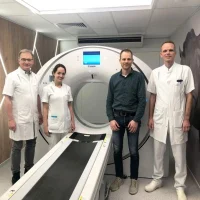A team of researchers at the Beckman Institute received a four-year $2M award in funding from the National Institutes of Health to create a device that could make high-quality medical imaging more accessible in diverse communities.
Professor Pengfei Song,researcher at the Beckman Institute, reinforces the importance of ensuring that ultrasounds remain one of the most cost-effective medical imaging technologies.
He explained that, “It’s the natural first stop in increasing accessibility to many clinical applications, such as providing care for patients suffering from cardiovascular diseases or cancer”.
Ultrasound technologies are mostly operating in 2D, limiting the range of view for clinicians, making it difficult for them to interpret the image of a tumor, tissue, or internal organ. During a 2D ultrasound scan, objects may appear larger or smaller than they are, which can be caused by even the smallest change in the angle of the probe.
However, with 3D ultrasound systems, it is possible for the whole object and surrounding environment to be captured.
The new device, known as FASTER,is designed to enable real-time 3D ultrasound imaging. It uses a clip-on technique to easily integrate with the 2D ultrasound probes that many clinicians already own.
Although 3D systems are available in clinics, they are mainly employed within high-end facilities for specialised care. Therefore, this device provides a solution that is accessible, low-cost and can be used wherever 2D ultrasound imaging systems are used.
The development of pocket-sized, handheld ultrasound imaging systems means many more ultrasound imaging procedures can be conducted by non-expert individuals; non-experts can use 3D imaging to scan the general location requiring attention, and the image can be interpreted by a physician.
Zhijie Dong, researcher of the device,added, “We hope that access to 3D technology will drastically improve the level of care that clinics can offer”.
FASTER is made with small, fast-tilting mirrors allowing it to sweep the ultrasonic waves while the probe remains still– enhancing the speed of 3D imaging systems.
Overall, this device is aimed to make high-quality medical imaging more affordable and accessible to diverse communities.
Source: Beckman Institute
Image Credit: iStock










